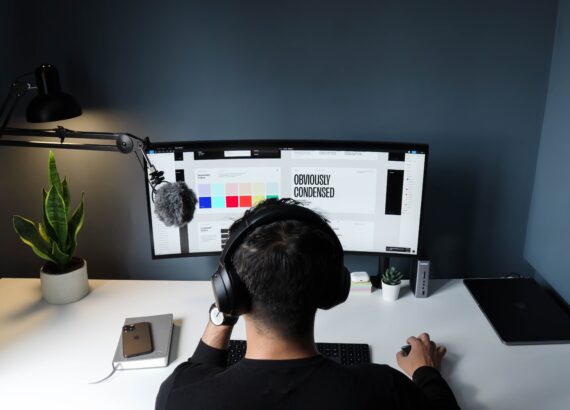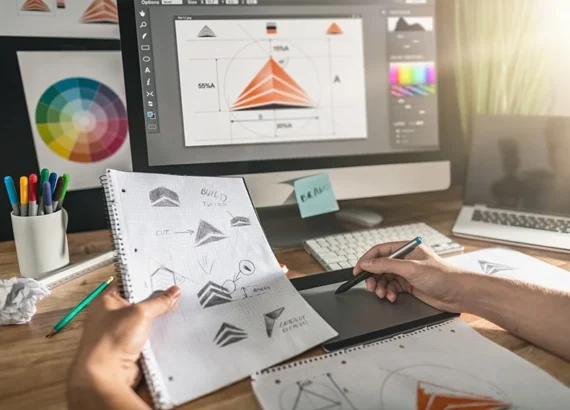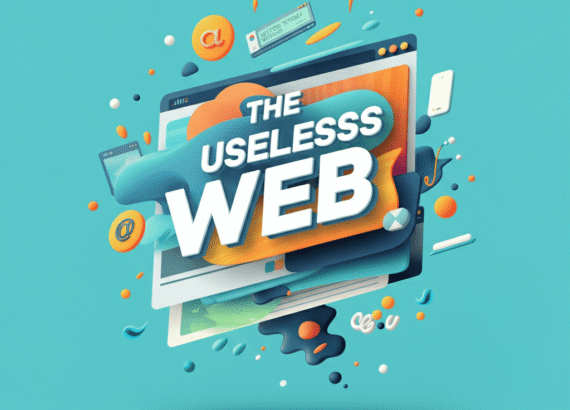The Evolution of Visual Communication in Graphic Design: From Print to Computerized
Graphic design is a dynamic field that has undergone significant transformations throughout history. From its humble beginnings as cave paintings and handcrafted manuscripts to the digital age of websites and mobile applications, graphic design has evolved alongside technological advancements and cultural shifts. This article delves into the fascinating journey of graphic design, tracing its roots in print media and exploring its transition into the digital realm. By examining key historical periods, technological breakthroughs, and emerging trends, we aim to uncover how graphic design has adapted and innovated to meet the ever-changing demands of visual communication.
1. Introduction: Exploring the Transformation of Graphic Design
Graphic design is not just about creating pretty pictures; it’s a powerful tool for communication. From advertising to branding, graphic design has become an essential aspect of our visual culture. Over the years, graphic design has evolved significantly, adapting to the changing technological landscape. In this article, we will delve into the journey of graphic design, from its early days in print to its current digital form.
The Importance of Graphic Design in Communication
Graphic design plays a pivotal role in conveying messages effectively. It helps businesses and individuals communicate their ideas, products, and services to the world. An eye-catching logo, a well-designed brochure, or a visually appealing website can captivate audiences and leave a lasting impression. Graphic design combines elements such as colour, typography, imagery, and layout to create powerful visual compositions that convey meaning and evoke emotions.
The Evolutionary Journey of Graphic Design
From ancient cave paintings to Johannes Gutenberg’s printing press revolutionizing mass communication, each era has contributed to shaping graphic design as we know it today. This journey has seen various printing techniques, design movements, and technological advancements that have influenced the field’s growth and potential.
2. The Early Era of Print Design: Historical Context and Techniques
Birth of Graphic Design: From Cave Paintings to Gutenberg’s Printing Press
Graphic design’s roots can be traced back to prehistoric times when early humans used cave paintings and rock art to convey messages and record events. Fast forward to the 15th century, and Johannes Gutenberg’s invention of the printing press marked a significant milestone in the world of graphic design. This revolutionary technology made it possible to produce multiple copies of books and other printed materials, leading to the birth of modern graphic design.
Printing Techniques and Tools: Woodblock Printing, Letterpress, and Lithography
Before the printing press, various printing techniques were employed, such as woodblock printing and letterpress. Woodblock printing involved carving images into wooden blocks, which were then coated with ink and pressed onto paper. Letterpress, on the other hand, utilized raised metal type that was inked and pressed onto the paper’s surface. Later, lithography introduced the use of stones or metal plates to transfer ink onto paper, allowing for more intricate designs and colours.

3. Bridging the Gap: Transitional Periods and the Rise of Computer-Aided Design
The Influence of Industrialization on Graphic Design
The Industrial Revolution brought about significant changes in society, and graphic design was not immune to its effects. With the rise of mass production and consumerism, graphic design became an integral part of advertising and marketing. The need for visually appealing designs that could captivate a larger audience grew, pushing graphic designers to explore new techniques and aesthetics.
Introduction of Computer-Aided Design: From Hand-drawn to Digital
The advent of computers in the mid-20th century marked another turning point in the evolution of graphic design. With the introduction of computer-aided design (CAD) software, designers could now create and manipulate designs digitally. This transition from traditional hand-drawn techniques to computer-based design opened up a world of possibilities, allowing for greater precision, flexibility, and efficiency in the design process.
4. The Digital Revolution: Exploring the Impact of Technology on Graphic Design
Emergence of Desktop Publishing Software: Revolutionizing Design Processes
As technology continued to advance, the emergence of desktop publishing software in the 1980s revolutionized the field of graphic design. Programs like Adobe Photoshop, Illustrator, and InDesign gave designers unprecedented control over their creations. Designers could now easily manipulate images, experiment with typography, and layout designs with ease, streamlining the design process and pushing creative boundaries.
The Internet’s Influence: Websites and Online Content Design
With the rise of the internet in the late 20th century, graphic design found a new platform to showcase its potential. Websites and online content design became crucial in capturing users’ attention in the ever-expanding digital landscape. Designers now had to consider factors such as user experience, responsive design, and interactive elements, as they crafted visually engaging digital experiences. The internet opened up a global stage for graphic design, allowing designers to reach a wider audience and explore new creative possibilities.
In conclusion, graphic design has undergone a remarkable transformation, transitioning from the print era to the digital age. This evolution has been driven by technological advancements, societal changes, and the ever-increasing demand for impactful visual communication. As graphic design continues to adapt, it remains an integral part of our daily lives, shaping the way we perceive and interact with the world around us.
5. From Static to Interactive: Embracing the Era of Web and Mobile Design
Interactive Design: Transitioning from Printed Pages to Dynamic User Experiences
Gone are the days of static layouts and pages that just sit there looking pretty. With the advent of the internet and mobile devices, graphic designers now have the opportunity to create interactive experiences that engage and captivate users. Whether it’s a website, an app, or even a social media post, interactive design allows designers to weave a narrative and guide users through a visual journey. It’s like taking your design off the page and giving it a life of its own.
Responsive Design: Adapting Graphic Design for Different Devices
In a world where people access the internet from a multitude of devices, responsive design has become a critical aspect of graphic design. No longer can we create designs that only look good on a desktop computer; they need to adapt and respond to different screen sizes and orientations. This means considering how elements rearrange or resize themselves to ensure optimal viewing on smartphones, tablets, and everything in between. It’s all about making sure your design looks great, no matter where it’s being viewed.
6. The Modern Landscape: Integrating Digital Tools and Traditional Design Principles
Blending Old and New: Incorporating Traditional Design Principles in Digital Media
While digital design has opened up a whole new realm of possibilities, it doesn’t mean we should abandon the tried-and-true principles of traditional design. Elements like composition, contrast, colour, and typography still play a vital role in creating visually appealing and effective designs. By blending the foundations of traditional design with the flexibility and interactivity of digital tools, designers can create captivating visuals that stand the test of time.
Software and Tools: Enhancing Creativity and Efficiency in Graphic Design
Gone are the days of rulers, paintbrushes, and physical paste-ups. Graphic designers now have an arsenal of powerful software and tools at their fingertips to bring their creative visions to life. Whether it’s Adobe Creative Cloud or other design software, these tools offer a wealth of features and resources that make the design process faster and more efficient. From creating intricate illustrations to manipulating typography with ease, these digital assistants are every designer’s best friend.
7. Trends and Innovations: A Look at Contemporary Graphic Design Practices
Minimalism and Flat Design: Simplifying Visual Communication
In an age of information overload, simplicity is key. Minimalism and flat design have become dominant trends in contemporary graphic design, with their clean lines, bold colours, and absence of unnecessary embellishments. These styles prioritize clarity and ease of understanding, conveying messages in a visually appealing and straightforward manner. After all, why use ten elements when one will do the job?
Typography and Branding: Creating Memorable and Cohesive Identities
Typography is no longer just about choosing a font; it’s an essential tool in building brand identities. Unique and carefully selected typography can convey emotions, establish a brand’s personality, and differentiate it from competitors. From bold and expressive typefaces to delicate and elegant scripts, designers now have a world of options at their disposal to create memorable and cohesive visual identities that leave a lasting impression.
8. The Future of Graphic Design: Anticipating Further Evolution and Possibilities
Virtual and Augmented Reality: Expanding Graphic Design into Immersive Experiences
As technology advances, graphic design is evolving beyond the realm of 2D screens. Virtual reality (VR) and augmented reality (AR) are increasingly being integrated into design practices, allowing designers to create immersive experiences that bridge the gap between the physical and digital worlds. Imagine being able to explore a virtual environment or interact with products and information in real time. The possibilities are endless, and graphic designers are at the forefront of this exciting frontier.
Artificial Intelligence and Automation: How Technology is Shaping the Future of Design
Artificial intelligence (AI) and automation are transforming industries across the board, and graphic design is no exception. From automated layout generation to AI-powered image recognition and editing, these technologies have the potential to streamline the design process and free up time for designers to focus on the creative aspects. While some may fear that AI will replace human designers, it’s more likely that it will enhance their capabilities, allowing them to explore new creative territories and push the boundaries of graphic design even further.
In conclusion, the evolution of graphic design from print to digital has revolutionized the way we communicate and interact with visual content. The transition from static print materials to dynamic digital experiences has opened up endless possibilities for creativity and engagement.
As technology continues to advance, graphic designers must stay adaptable, embrace new tools and techniques, and balance traditional design principles with emerging trends. By understanding the rich history and ongoing evolution of graphic design, we can appreciate the artistry and skill behind every visual communication we encounter in our daily lives.
FAQ
1. How has technology impacted the field of graphic design?
Technology has had a profound impact on graphic design by revolutionizing the tools and processes used by designers. The introduction of computer-aided design software and digital platforms has increased efficiency, expanded creative possibilities, and facilitated the seamless integration of design across various mediums such as print, web, and mobile.
2. What are some notable trends in contemporary graphic design?
Contemporary graphic design is characterized by a range of trends and innovations. Minimalism and flat design, with their clean lines and simplicity, have gained popularity for their ability to convey information effectively. Typography has also become a focal point, with designers experimenting with diverse fonts and creative arrangements. Additionally, branding has become crucial in creating memorable and cohesive visual identities for businesses and organizations.
3. How has the role of graphic designers changed in the digital era?
In the digital era, graphic designers have become more versatile and multidisciplinary. They are expected to possess a strong foundation in traditional design principles while also being proficient in digital tools and technologies. Designers now often work across various mediums, creating websites, mobile apps, social media graphics, and more. Additionally, the need for user-centred design and interactive experiences has prompted designers to focus on creating engaging and intuitive interfaces.
4. What does the future hold for graphic design?
The future of graphic design is likely to be shaped by emerging technologies such as virtual reality, augmented reality, and artificial intelligence. These advancements offer new opportunities for designers to create immersive and interactive experiences. With the continued integration of technology into our daily lives, graphic designers will play a crucial role in crafting visually compelling and meaningful communication in both digital and physical spaces.
Thank you for reading 🙂
Get up to 70% Discount on Amazon Electronic Products
If you want to build your website at an affordable price contact: www.nextr.in
Read this: Top 8 Apps Every Entrepreneur Needs


















